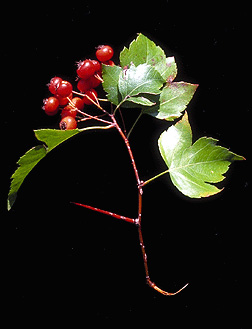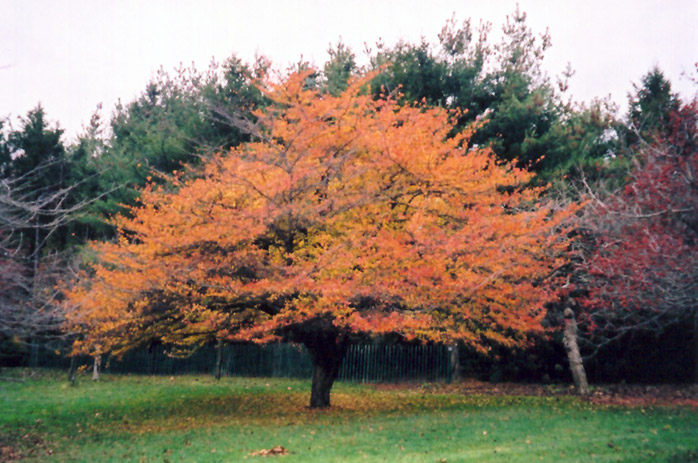HawthornRay Novitske2019-02-09T23:07:53-04:00
Name That Tree
By Carmine Carosella, Fairfax Master Gardener

Hawthorn fruit & leaves
If you chose B, Hawthorn, you are correct! The Hawthorn (Crataegus) is a small ornamental tree or shrub that is native to temperate regions of the Northern Hemisphere, including North America. It is in the rose family (Rosaceae) and has a large number of native species, easily over a hundred. As the common name implies, all have thorns. They also have white to pink flowers that appear mid- to late-spring, which become small, apple-like fruits that are edible. It is a great native tree or shrub as it provides shelter and food for wildlife.
In England, hawthorns were extensively used as hedgerows as far back as the Middle Ages. Kept pruned, the hawthorn has multiple trunks, and a row of them becomes an impenetrable barrier and perfect for wildlife. Hawthorns like to grow in sunny locations and will become small trees about 25 feet high if spurious trunks are removed.

Black hawthorn flower & leaves
Here in Virginia, hawthorns are plentiful in the wild and are also available in the nursery trade. We contacted the owner, Chris Bright, of the local wild plant nursery, Earth Sangha in Springfield, Virginia. He told us that they had collected seed at a site in Alexandria and were growing the ‘Frosted Hawthorn’
. This kind of Hawthorn has ovoid-shaped, alternating, dark green leaves with serrated edges. There are many other native species in Virginia, including the most plentiful one, the ‘Cockspur Hawthorn’ (C. crus-galli). All have thorns, white to pink flowers, small red or red-orange fruit and serrated leaves. They tend to grow in forest edges or meadows.

‘Winter King’ Hawthorn

Fall color
References
• Virginia Tech Dendrology Fact Sheets, Genus
Crataegus
• Earth Sangha Wild Plant Nursery, Franconia Park, Springfield, Virginia
• Crataegus viridis ‘Winter King’, The Ohio State University Pocket Gardener
• Medical Uses of Hawthorn, Gale Encyclopedia of Alternative Medicine



